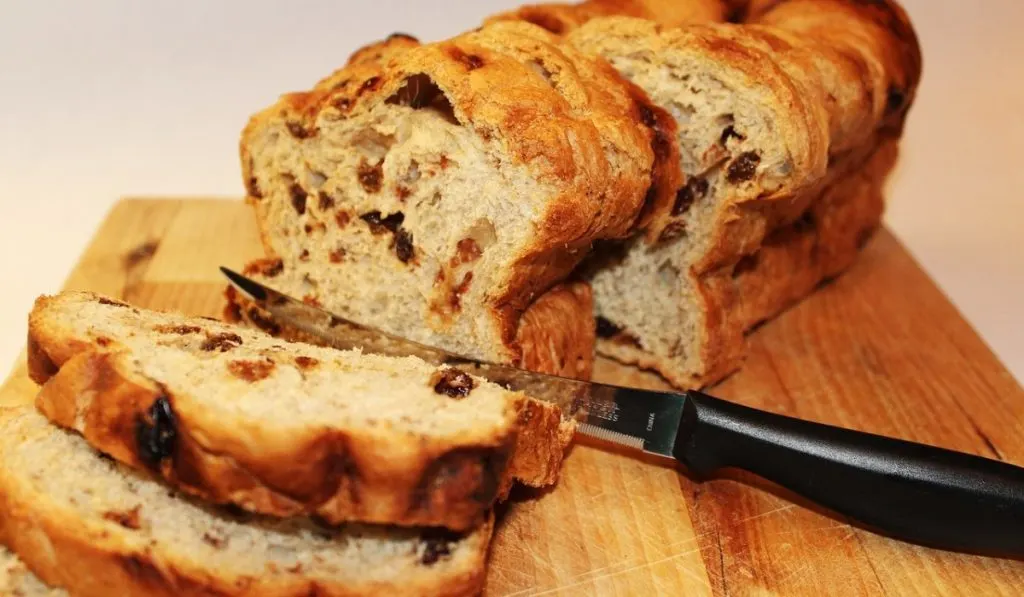
Is there anything more comforting than a warm slice of homemade cinnamon raisin bread? Imagine a crusty sourdough exterior giving way to a soft, tangy, and just-sweet-enough interior, studded with juicy raisins and a touch of cinnamon warmth. Making sourdough cinnamon raisin bread, though, can seem intimidating, but it doesn’t have to be!
In today’s guide, we’ll unravel the secrets of crafting the perfect sourdough cinnamon raisin bread that strikes a balance between sweet and sour, and will leave you questioning why you ever bought store-bought bread. Let’s get baking!
TL;DR
- Balance of flavors: Sweetness from raisins, slight tanginess from sourdough, and warmth from cinnamon.
- Perfect texture: Crusty on the outside, soft and chewy inside.
- Homemade freshness: Achieve superior taste and texture with homemade sourdough.
- Easy to make: Steps broken down to simplify the process for bakers of all levels.
- Secrets revealed: Tips to achieve bakery-level quality at home.
What’s the Secret to Great Sourdough Cinnamon Raisin Bread?
Good sourdough cinnamon raisin bread has a balance of slight sourness and natural sweetness. That mix is what makes this recipe stand out: it’s sweet without being cloying and has a hint of sourness that keeps you wanting another slice. The secret is in the sourdough starter, a bit of patience, and some small tweaks along the way.
Why Sourdough? The Unique Flavor and Benefits
In recent years, sourdough has surged in popularity, and for good reason! Not only does the natural fermentation add that distinct sour flavor, but it also makes the bread easier to digest and even boosts some nutrients. When combined with cinnamon and raisins, you get a complex, delightful taste profile that’s hard to replicate with commercial yeast.
What You’ll Need for This Recipe
- Active sourdough starter: For that perfect sour flavor
- Organic raisins: Preferably soaked for a juicier result
- Cinnamon: Choose high-quality, aromatic cinnamon for the best taste
- Bread flour: Provides structure and chewiness
- Water and salt: Essential for hydration and flavor balance
- Optional sugar or honey: For a slight additional sweetness
Step-by-Step Guide to Making Sourdough Cinnamon Raisin Bread
Step 1: Preparing the Raisins
Soaking the raisins before baking helps them stay plump and juicy. Place them in a bowl, cover with warm water, and let them soak for 10-15 minutes. Drain and set aside.
Step 2: Activating the Sourdough Starter
Use a lively, bubbly starter for the best results. A well-fed starter will help the bread rise effectively and provide that signature sourdough flavor. Feed your starter 6-8 hours before beginning this recipe to ensure it’s at its peak.
Step 3: Mixing the Dough
In a large mixing bowl, combine:
- 400g bread flour
- 250g water
- 100g sourdough starter
- 1 tsp salt
Mix until no dry spots remain. Cover and let rest for 30 minutes. This technique, known as autolyse, allows the flour to fully absorb water, resulting in better gluten development.
Step 4: Adding Raisins and Cinnamon
After the initial rest, sprinkle 1-2 teaspoons of cinnamon and the soaked raisins evenly over the dough. Gently knead until combined, folding and stretching the dough to distribute the ingredients without overworking it.
Step 5: Bulk Fermentation
Cover the dough and let it rise in a warm place for 4-5 hours. During this time, perform gentle stretch-and-folds every 30 minutes for the first 2 hours. This technique strengthens the dough and ensures an even rise.
Step 6: Shaping the Dough
After the bulk fermentation, turn the dough onto a lightly floured surface. Shape it into a round or oval loaf, depending on your preference. Let it rest for 10-15 minutes to relax the gluten, then perform a final shaping.
Step 7: Proofing the Dough
Place the dough in a proofing basket and cover with a cloth. Let it proof in the fridge overnight or for at least 8 hours. This cold fermentation enhances the flavor and texture of the bread.
Baking the Sourdough Cinnamon Raisin Bread
Preheat the Oven
Start by preheating your oven to 450°F (232°C). Place your Dutch oven, complete with its lid, inside the oven as it heats up. This technique is crucial because preheating the Dutch oven allows for intense initial heat, which gives the bread its signature rise and a beautifully crisp crust.
The enclosed space within the Dutch oven also traps steam released from the dough as it bakes, creating an ideal environment for a perfectly chewy crust. This steam helps delay crust formation just long enough for the bread to reach its full height before solidifying into a golden shell. Without this added steam, the crust may harden too soon, limiting your loaf’s rise and creating a denser crumb.
Bake the Bread
Carefully transfer your shaped dough from the proofing basket onto a piece of parchment paper to make it easier to handle and prevent sticking. Score the top of your dough with a sharp blade or bread lame, making a few shallow slashes to guide the bread’s expansion during baking. These slashes not only make for a lovely appearance but also prevent the bread from tearing unpredictably as it rises.
Once your oven has reached temperature, using oven mitts, take out the preheated Dutch oven, remove the lid, and carefully lower the parchment paper with the dough into the hot Dutch oven. Immediately cover with the lid and return it to the oven. Bake covered for 20 minutes to retain maximum steam, then remove the lid and continue baking uncovered for an additional 20-25 minutes. This final baking period allows the crust to turn a deep, caramelized golden brown, while the inside continues to cook to a soft, fluffy texture. Check that the internal temperature reaches 200°F (93°C) to confirm it’s fully baked.
Cool and Enjoy
After baking, transfer your loaf to a wire rack to cool completely, which should take at least one hour. Cooling is essential to let the flavors and texture set, as the steam continues to evaporate, creating a balanced moisture level inside the bread. Cutting too early can lead to a gummy interior and compromise the integrity of your loaf. Waiting may be the hardest part, but your patience will be rewarded with a perfectly textured slice.
Expert Tips for the Best Sourdough Cinnamon Raisin Bread
- Fresh spices are key: High-quality cinnamon not only gives a robust flavor but also maintains its aromatic properties through baking. Try Ceylon or Saigon cinnamon for an even bolder taste.
- Soak your raisins: Soaking your raisins in warm water (or even a little apple juice for extra sweetness) for 10-15 minutes ensures they’re plump and prevent them from scorching during baking. Well-soaked raisins add delightful bursts of sweetness without drying out the crumb.
- Experiment with add-ins: Add-ins like walnuts or pecans complement the cinnamon and raisin combination beautifully, providing a satisfying crunch and added depth of flavor. You can also try adding a handful of oats for a rustic texture.
- Be patient: Sourdough bread rewards those who wait. The extended fermentation process not only enhances flavor but also improves the bread’s digestibility and texture. Slow-rising sourdough creates a depth of flavor that you simply can’t rush.
Conclusion
There you have it! The perfect sourdough cinnamon raisin bread that combines the natural tang of sourdough with the comforting flavors of cinnamon and raisins. This recipe is ideal for breakfast, snacks, or even a sweet-savory sandwich. With these steps, baking this delicious loaf will become a regular part of your sourdough routine!
FAQs
How do I know when my sourdough starter is ready?
Your starter is ready when it’s doubled in size, has bubbles on the surface, and smells pleasantly sour.
Can I add other spices?
Yes! Nutmeg, cardamom, or cloves can enhance the flavor of this bread.
How do I store sourdough cinnamon raisin bread?
Store it in a bread bag or airtight container for up to a week, or freeze for up to 3 months.
Why is my bread dense?
Dense bread could result from an underactive starter or not enough bulk fermentation time.
Can I make this bread gluten-free?
Gluten-free sourdough is tricky, but some recipes use alternative flours like rice or buckwheat.
Is it necessary to use a Dutch oven?
While a Dutch oven gives the best results, a baking stone with steam can work as well.
What can I use instead of raisins?
Cranberries, chopped dates, or dried apricots work well as substitutes.
Why is my crust too hard?
This can happen from baking too long or not enough steam in the oven. Adjust bake time or add water to the oven for steam.
Can I make a larger batch?
Yes, simply double or triple the ingredients. Adjust rise times if necessary.
What should I serve with this bread?
This bread pairs beautifully with butter, honey, or cream cheese.
Join Us and Transform >
Don’t Be an Amateur! Master the Art of Sourdough Bread!




Leave a comment